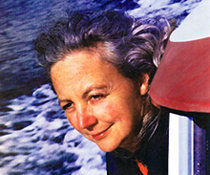
The federal government rejected an application Friday by biologist Alexandra Morton to evacuate wild salmon out of the path of Broughton Archipelago fish farms, putting the outspoken researcher in a precarious position: risk a $100,000 fine, or let migrating juvenile pink and chum salmon run a gauntlet of farms she says will ensure their destruction.
Morton had applied to the Department of Fisheries and Oceans (DFO) for a licence to transport salmon as part of her widely publicized plan to ferry young Ahta River pink and chum salmon past two fish farms operating in their migration path.
"I must advise you that the department does not support your proposal to capture and transport Ahta River juveniles past the fish farms in the area," wrote Paul Sprout, Regional Director for DFO's Pacific Region in a prepared statement. "...the department believes that the capture, transport and release of these fish has the potential to do more harm than good."
But even before Morton had read these words, she was already considering breaking the law if the decision did not go her way.
"It's difficult to communicate the feeling of watching these fish be destroyed year after year," she told The Tyee on April 2. "I know that down the line, I will want to know I've done everything I can to save these fish. I really don't want to do this without a permit, but yes, I am willing."
The death of the Meetup
Ask Morton why she is willing to face such penalties -- including an additional $100,000 and up to a year in jail for each subsequent offence -- and talk inevitably turns to the death of the Meetup River last year.
The Meetup appears on most maps as the Viner River, a chum salmon stream that snakes across Gilford Island in the heart of the Broughton Archipelago, a cluster of islands set against the B.C. mainland east of Queen Charlotte Sound, not far from Port McNeill.
"I've been following the Viner chum since 2001, and every year they emerge from the river and swim straight into the path of this fish farm just west of the Burdwood Islands," she says. "They get infected with sea lice from the fish farm and die."
Viner chum have always run a precarious gauntlet on their path to the sea. In a run that once numbered 70,000 fish, they historically migrated into the waiting nets of the Alert Bay seine fleet at the mouth of the river, or were chased down by G-clan -- a pod of northern resident killer whales that returned to Viner Sound each spring to feast.
But the seiners and the killer whales are gone. Last fall, when just 89 chum spawners returned to the Viner, Morton officially declared this once-great salmon river dead. But with that pronouncement came a desperate plan to scoop up tiny salmon fry as they emerged from a nearby salmon river in the spring of 2008, transporting them beyond the fish farms.
"I've focused on [moving fry from] the Ahta River only right now, because I love that river, but all of the rivers here need this," she says of her medevac plan. "My hope was that if I could concentrate on just one river, DFO just might let me start doing this."
But with today's announcement, DFO will not allow her to move forward legally, making an already complex plan that much more complicated.
First plan to medevac fry
Morton originally planned to capture salmon as they emerged into the open ocean from the Ahta River using a 125-foot beach seine; one end of the net would be tied to the shore, and a speedboat would rive in a large circle to release the net. The net would be drawn increasingly smaller until a small pool remained full of baby fish. She planned to move them by bucket into a boat equipped with a water tank designed to continually refresh with fresh ocean water.
She had already identified an area to release the fry where the salinity of the water is very similar to that at the mouth of their natal Ahta River. Before the release, she planned to hold them in a pen to assess if any have been killed or injured, in order to alter the methodology or abandon the venture all together.
"One thing I had been discussing with DFO [in advance of the decision], is that it's probably not wise to take them all [from the river], just in case something I do is a problem. I want to work it out with them to take half or less. And I'll leave the others so I can study them as they go past the fish farms, so we'll know what happened to them too."
Desperate times, desperate measures
There are about 30 leases and at least 20 active fish farms across the Broughton Archipelago, most of which are situated on the migratory path of wild salmon as they emerge from their natal rivers each April and May into the ocean. Once in marine waters, they will hold for up to several weeks to grow, feed and adapt to the salt water.
It is during this time that fish farms in the Broughton Archipelago harbour the largest numbers of sea lice. Although these lice occur naturally on wild salmon, the concentration of up to 700,000 adult salmon on a farm can create an unnatural breeding ground. Morton says the juvenile wild fish that must migrate past such farms would never be otherwise exposed to such numbers of lice and are unable to survive the exposure of a single louse.
Morton's desperate response to sea lice is in part based on her own research, including a December 2007 study she co-authored in the journal Science, which concluded that pink salmon in the Broughton Archipelago could face imminent extinction.
"The louse-induced mortality of pink salmon is commonly over 80 per cent and exceeds previous fishing mortality," concludes the peer-reviewed study. "If outbreaks continue, then local extinction is certain, and a 99 per cent collapse in pink salmon population abundance is expected in four salmon generations."
The province has considered sea lice a serious problem in the Broughton Archipelago since at least February 2003, when Agriculture Minister Stan Hagen announced that all B.C. fish farms had to monitor and treat sea lice, in response to the drastic declines in wild pink salmon that historically spawned throughout this area.
Marine Harvest, the largest aquaculture company in the world and largest farmer in the Broughton, has at least 10 farms in the area. They dispute the findings of the Science paper, and have published advertisements in Vancouver Island papers beginning April 3 that they show sea lice is not a problem for wild salmon in the Broughton Archipelago.
"When you've been so brash as to claim extinction in four years, one becomes desperate to manipulate the situation," says Marine Harvest Canada spokesman Ian Roberts of Morton's medevac plan. He added that that the Science paper has been discredited by "20 leading scientists," although The Tyee has confirmed that no peer-reviewed science has appeared to refute this study to date.
Whacking sea lice with Slice
In February of 2008, Morton and a diverse coalition of First Nations, commercial fishermen, eco-tourism operators and environmentalists met with Agriculture and Lands Minister Pat Bell to request a provincial strategy of fallowing or emptying fish farms in the path of migrating fry salmon.
Minister Bell responded during the first week of March with a call for increased chemical treatments of lice-bearing farmed salmon, including a louse biocide known as Slice, which has recently emerged as the sea lice treatment of choice in B.C. waters.
Slice is controversial because it is not an officially approved drug for application for pest control; fish farmers must apply for an emergency application permit from government veterinarians. Environment Canada has historically voiced concerns over the "unknown fate" of Slice in the ocean -- where it is deposited on the sea floor as a component of farmed salmon feces or in unconsumed feed. The federal government has also warned that sea lice can develop resistance to the drug over time.
Marine Harvest says it has been harvesting fish farms in time for the spring wild salmon migration, and that it uses Slice very conservatively in the Broughton. On March 31, Marine Harvest announced it had completed its 2008 sea lice control program, harvesting at least four farms and applying Slice to the rest.
Alexandra Morton concedes that Slice treatments have reduced sea lice on the wild salmon she observes, but not enough to spare the pink fry that often measure an average three centimetres and cannot withstand the attack of a single louse.
She also disputes Marine Harvest's statistics about low average sea lice abundance as misleading, because the farmers only measure the number of lice found on adult fish inside the pens, and do not consider sea lice spread and reproduction in the adjacent marine environment.
"If there are 600,000 farm fish at a site and 75 per cent of them have sea lice, then that's 450,000 lice. If every female louse has 250 babies every two weeks, that's about 56 million lice larvae coming from that single farm every two weeks. And that spells serious trouble for migrating juvenile wild salmon, unless something else can be done."
Related Tyee stories:
- A Fish Farm Critic Vindicated
New research bolsters Morton's claims of sea lice devastation. - Ministry Fish Farm Biologists Won't Be Penned
None joined expert body Libs created for 'public interest.' - Push North for Fish Farms Blocked
Gitxsan Nation thwarts planned 'critical mass' of farms. A Tyee Special Report.
Read more: Food, Labour + Industry, Science + Tech, Environment
















Tyee Commenting Guidelines
Comments that violate guidelines risk being deleted, and violations may result in a temporary or permanent user ban. Maintain the spirit of good conversation to stay in the discussion.
*Please note The Tyee is not a forum for spreading misinformation about COVID-19, denying its existence or minimizing its risk to public health.
Do:
Do not: